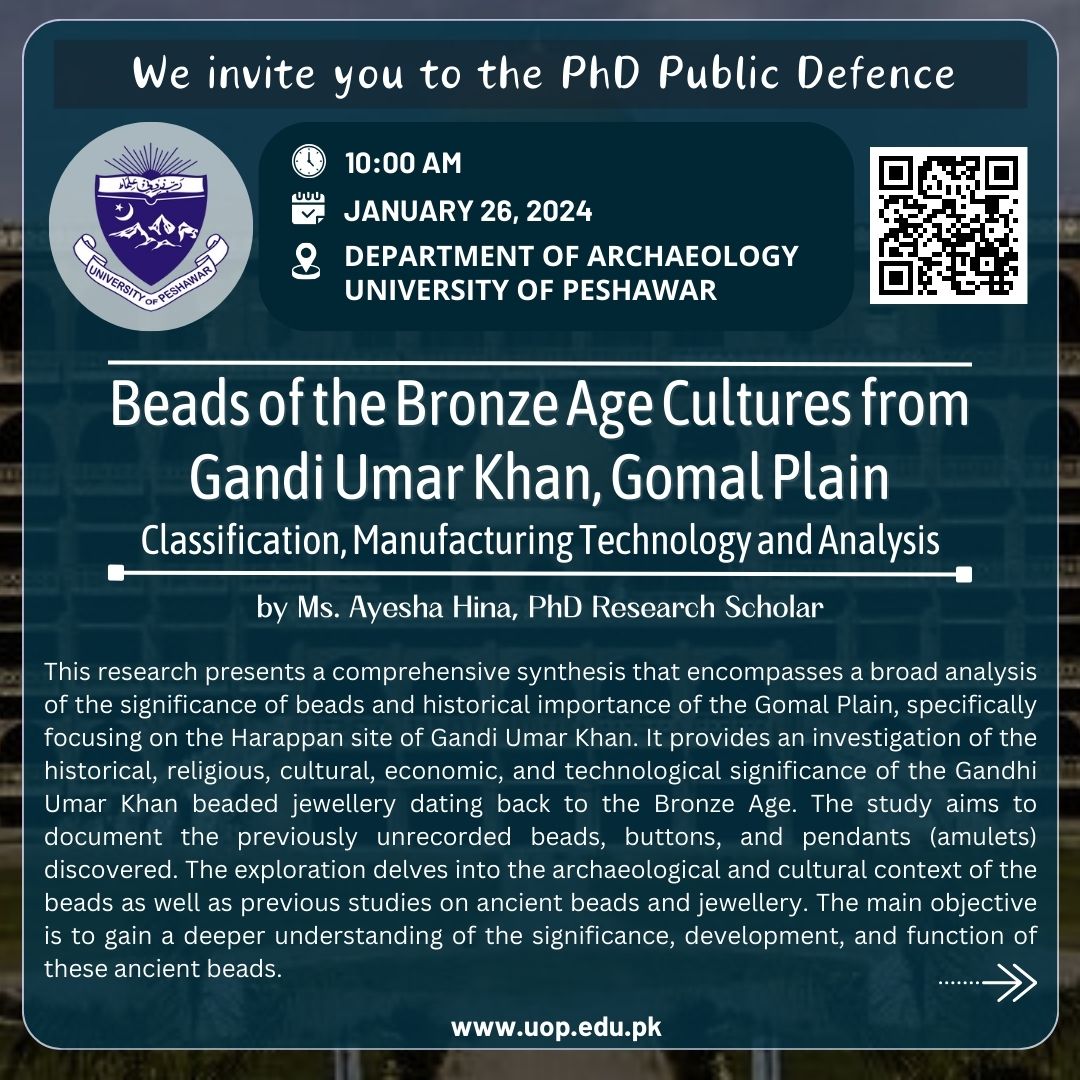PhD Public Defence of Ms. Ayesha Hinna (research scholar Archaeology)
NOTIFICATION
Ms. Ayesha Hinna, Ph.D. Research Scholar has submitted thesis on "BEADS OF THE BRONZE AGE CULTURES FROM
GANDI UMAR KHAN, GOMAL PLAIN: Classification, Manufacturing Technology and Analysis" to the University of Peshawar, in partial fulfillment of the requirements for the award of degree of Doctor of Philosophy (PhD) in Archaeology.
The oral examination (Public Defence) is scheduled to be held on January 26, 2024 at 10:00 am in the Department of Archaeology, University of Peshawar. The abstract of the thesis is attached herewith.
All those interested in the said research work may participate in the event they may raise relevant questions during presentation by the scholar for further evaluation.
Abstract
This research presents a comprehensive synthesis that encompasses a broad analysis of the significance of beads and historical importance of the Gomal Plain, specifically focusing on the Harappan site of Gandi Umar Khan. It provides an investigation of the historical, religious, cultural, economic, and technological significance of the Gandhi Umar Khan beaded jewellery dating back to the Bronze Age. The study aims to document the previously unrecorded beads, buttons, and pendants (amulets) discovered. The exploration delves into the archaeological and cultural context of the beads as well as previous studies on ancient beads and jewellery. The main objective is to gain a deeper understanding of the significance, development, and function of these ancient beads.
Exploring the archaeological significance of beads involves delving into their definition, importance in human society, and their usage in ancient civilizations. Insight is acquired by examining the beads uncovered at the Gandi Umar Khan Site. An analysis is being conducted on the quantity of beads material over various cultural periods. The purpose of this analysis is to present detailed information about each bead in a table format. The table presents information about the bead's raw material, location within the site (trench and layer), cross section, shape, length, condition, exterior surface, and production stage. The investigation encompasses all unpublished decorative artifacts (beads, buttons, and pendants) as well as a small amount of published artifacts, namely beads.
This thesis provides an investigation and thorough analysis of manufacturing technologies involved in the production process of various material beads, offering a foundation for understanding and appreciating the artistry of bead making. Analysing the material and shapes of the beads, a comprehensive study is conducted on the various sources of bead materials and the trade networks during the 3rd millennium BC, with a particular emphasis on the beads of Gandi Umar Khan, which provides valuable information about the extent of trading activities and the economic situation of the Indus Valley Civilization.
This research investigates the prevalence with which Gandi Umar Khan beads have social, cultural, and economic significance. Within the social domain, the beads are analysed in terms of their role as a symbol of wealth and social status, as an expression of cultural identity, and as an indication of hierarchy. The examination of the symbolic and religious importance of beads at the location, impacted by their distinct material and shapes, has yielded understanding about their initial use in religious context. Furthermore, the economic significance of beads is examined based on the use of valuable materials such as gold, tin bronze, semi-precious beads, and the advanced manufacturing techniques used in their production. Ultimately, it provides a concise summary of the primary insights derived from all of the analyses. This information elucidates the significance, typology, technological development and function of the beads during Bronze Age in the Gandi Umar Khan and testifies the role of the Gandi Umar Khan as the major urban centre during the Harappan era.

